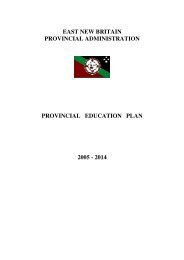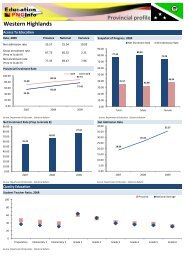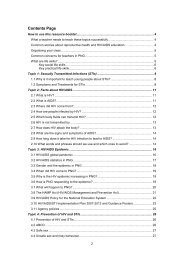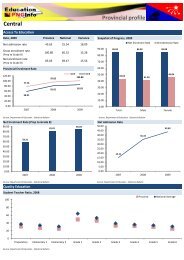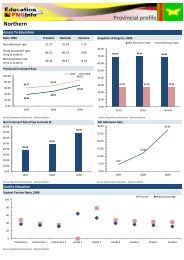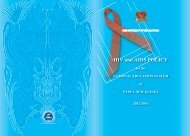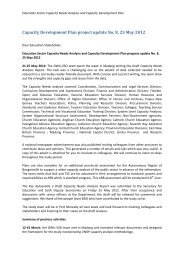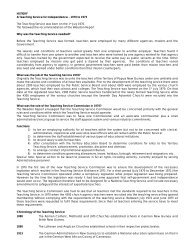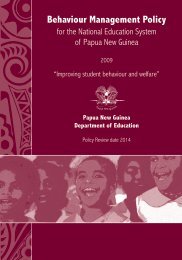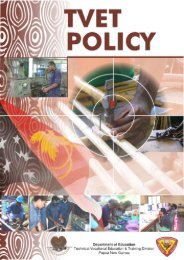Medium Term Development Plan, 2011-2015 - UNDP in Papua New ...
Medium Term Development Plan, 2011-2015 - UNDP in Papua New ...
Medium Term Development Plan, 2011-2015 - UNDP in Papua New ...
Create successful ePaper yourself
Turn your PDF publications into a flip-book with our unique Google optimized e-Paper software.
5.2 Youth<br />
Goal:<br />
A vibrant and productive youth population that has career opportu nities, skills, good<br />
education, moral values and respect<br />
Introduction<br />
The PNG population has a youthful structure with 40 per cent aged 0-14, 20 per cent aged 15-24, and 16 per<br />
cent aged 25-34. In total, 76 per cent of the population is 34 years or younger. The recently revised National<br />
Youth Policy recognises that there are young people who are over 25 but still identified as “young people” and<br />
they ma<strong>in</strong>ta<strong>in</strong> an active <strong>in</strong>volvement <strong>in</strong> community youth activities. It must be recognised that the needs and<br />
issues of youth can vary considerably between the ages of 12 and 25 and between different life circumstances<br />
and locality. Young people are mobile; hence there is a trend of rural to urban migration of youths for reasons<br />
<strong>in</strong>clud<strong>in</strong>g: education and employment opportunities; an attraction to a different way of life; to remove<br />
themselves from the restrictions of their villages and from family obligations; abuse and violence; to access<br />
services; sports and recreation; and for pleasure. There are also young people who have been born <strong>in</strong> urban<br />
areas and raised <strong>in</strong> the city. They do not necessarily go to their family’s home villages or speak their parent’s<br />
native languages but speak PNG Tok Pis<strong>in</strong> and English. Youths also migrate from urban and rural areas to<br />
places where economic development is occurr<strong>in</strong>g, for example, around logg<strong>in</strong>g camps, m<strong>in</strong>es, oil fields, and<br />
plantations.<br />
Urban settlements have <strong>in</strong>creased <strong>in</strong> size, and overcrowd<strong>in</strong>g and lack of services create vulnerability to<br />
communicable diseases. In settlement areas, large numbers of unemployed youths, without land or jobs,<br />
become gang members that engage <strong>in</strong> unlawful activities to earn a liv<strong>in</strong>g, such as break<strong>in</strong>g and enter<strong>in</strong>g, hold<br />
ups, and shop lift<strong>in</strong>g. There is a lack of educational and employment opportunities to meet the needs of young<br />
people and, as a result, poverty and unemployment are critical issues for the youth population <strong>in</strong> PNG.<br />
Moreover, young people f<strong>in</strong>d it difficult to access micro-f<strong>in</strong>ance schemes or small grants to assist them to get<br />
<strong>in</strong>volved <strong>in</strong> susta<strong>in</strong>able <strong>in</strong>come generation activities. Youth issues are a real threat and a challenge for the<br />
government vision of a happy, fair, wealthy and smart country by 2050. The youth are the future of PNG and<br />
the PNGDSP 2010-2030 focuses on nurtur<strong>in</strong>g young people so that they become agents of change <strong>in</strong> the<br />
society. The nurtur<strong>in</strong>g will start with families where parents take a serious role <strong>in</strong> car<strong>in</strong>g for and responsibly<br />
br<strong>in</strong>g<strong>in</strong>g up their own offspr<strong>in</strong>g. Strategies for education, employment generation, crime control, and<br />
HIV/AIDS are all critical for improv<strong>in</strong>g the lives of young people today and <strong>in</strong> the future. In addition, sport<br />
and recreation activities need to be developed as discussed <strong>in</strong> section 5.15. Counsell<strong>in</strong>g programs through<br />
partnership with churches and NGOs are the way forward <strong>in</strong> creat<strong>in</strong>g social and spiritual opportunities for<br />
young people to identify their potential and their usefulness for positive liv<strong>in</strong>g and advancement <strong>in</strong> life.<br />
MTDP <strong>2011</strong>-<strong>2015</strong><br />
To improve outcomes for youth, <strong>in</strong>vestment <strong>in</strong> education, particularly <strong>in</strong> the promotion of polytechnic<br />
programs, is paramount. Polytechnic programs will equip young people with the technical and entrepreneurial<br />
skills they require to effectively participate <strong>in</strong> the develop<strong>in</strong>g and vibrant PNG economy. The Government will<br />
also focus on recapitalis<strong>in</strong>g youth centres to provide an avenue for youth activities to be coord<strong>in</strong>ated.<br />
Investment <strong>in</strong> sports and recreation, employment generation, culture and community programs through<br />
strong partnership with churches, NGOs and community based organisations are crucial mechanisms to<br />
transform the m<strong>in</strong>dset of our youth population and to develop them to become vibrant and productive<br />
participants of society.<br />
Build<strong>in</strong>g on MTDP <strong>2011</strong>-<strong>2015</strong><br />
Future MTDPs will build upon progress <strong>in</strong> MTDP <strong>2011</strong>-<strong>2015</strong> and cont<strong>in</strong>ue to <strong>in</strong>vest <strong>in</strong> youth <strong>in</strong>itiatives,<br />
<strong>in</strong>clud<strong>in</strong>g polytechnic tra<strong>in</strong><strong>in</strong>g. Work will cont<strong>in</strong>ue on development of youth skills tra<strong>in</strong><strong>in</strong>g and personal<br />
development programs. Capacity build<strong>in</strong>g through the creation of tra<strong>in</strong><strong>in</strong>g centres and facilities will act as a<br />
launch pad for <strong>in</strong>creased youth participation <strong>in</strong> the future, contribut<strong>in</strong>g to the 2030 target. Effective<br />
<strong>in</strong>vestment <strong>in</strong> youths will br<strong>in</strong>g about changes <strong>in</strong> their behaviour and attitudes whilst also contribut<strong>in</strong>g to<br />
significant economic ga<strong>in</strong>s <strong>in</strong> the form of employment, <strong>in</strong>creased entrepreneurship, law and order,<br />
productivity and reliability of an educated healthy population.<br />
Challenges <strong>in</strong> implementation<br />
In order to realise positive change <strong>in</strong> youth development, effective prioritisation and sequenc<strong>in</strong>g of expenditure<br />
must take place. Sett<strong>in</strong>g the right foundation <strong>in</strong> MTDP <strong>2011</strong>-<strong>2015</strong> through sound <strong>in</strong>vestment <strong>in</strong> the key<br />
enablers is one way <strong>in</strong> which this can be done. Moreover, only by enhanc<strong>in</strong>g employment opportunities will<br />
our youth be able to be a truly productive and vibrant part of society.<br />
93



